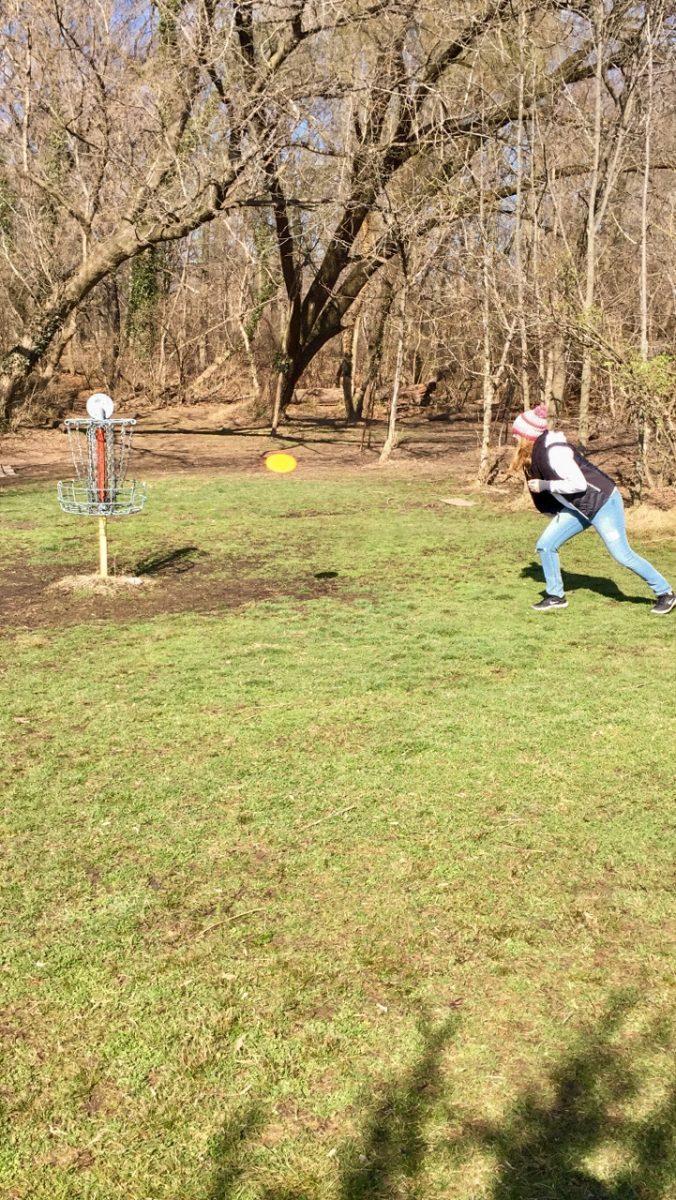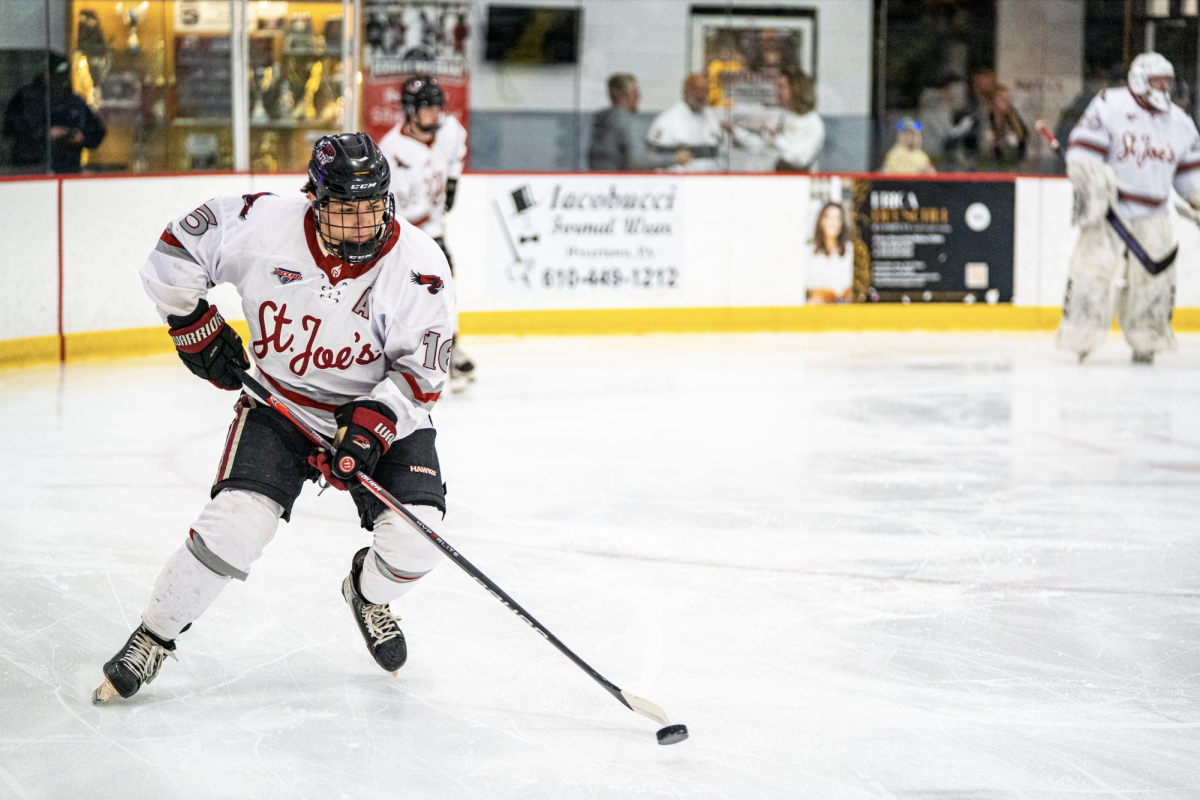St. Joe’s student takes to local disc golf course
There’s nothing like a lime green fanny pack, a self-made handbook and a bag of discs to make you look (and feel) like a total dork on the disc golf course.
One morning, I’d risen early to beat the crowds at Fairmount Park’s Sedgley Woods. I had the disc golf grounds, seemingly, to myself.
Sedgley is one of the oldest disc golf courses in the world, and is celebrating its 40th anniversary this year. Yet, for a course riddled with 40 years of flying discs and busy feet, the grounds are still lush and lively—essentially, how I hope to look at 40 if I were a disc golf course.
Ready and prepared to play disc golf for the first time, I hyped myself up by remembering just how closely I studied the rules prior to venturing out onto the course. I rattled them off in my head: The object of the game is much like real golf; lowest score and fewest strokes wins; always throw your next disc from where the previous one landed. There is a mix of tight skill shots through wooded areas, open spaces for full force driver shots and tricky water hazards that will swallow up your disc.
Prep over, I scanned the grounds.
Although I brought my own discs, Sedgley rents discs for a small donation of one or two dollars and players can even buy discs on-site for less than $10.
Luckily for me, my boyfriend is an avid player of the sport, so for my first round of play, I borrowed his discs—my first “score” of the day.
With my fanny pack, handbook and discs, I delicately approached the first hole. The basket looked intimidating with its silver chains and yellow topper swinging in the wind. How was I ever going to get my disc into that tiny basket?
I peered into my bag of discs, unsure of which to use.
As in regular golf, there are drivers, midranges and putters. All three types of discs boasted various curves that determined speed, control, and distance.
I kind of hoped one would just jump out at me.
I picked my driver, “The Destroyer,” as named by the disc company. It’s a sharper-edged disc built for speed, and it’s a little thinner, too. As soon as it was in my hands, I realized how different this disc felt; it was nothing like a regular Frisbee. The Destroyer was heavier, somehow and had a very specific shape.
Feeling a bit nervous, I decided to pull out my trusty handbook for some guidance. And, of course, I kept my handbook in my fanny pack. The style was uncanny.
Once I had the book in my hands, which I admit, was truly self-made from tips I learned on Professional Disc Golf Association’s (PDGA) instructional site, I read “play begins on each hole with the player throwing from the tee area, usually 150-500 feet away from the basket.”
I inched up to 149 and a half feet. I didn’t know how this was going to go.
As I held the disc, I recalled a tip that senior Keira McHugh co-leader of the Saint Joseph’s University Ultimate Frisbee team told me.
“It’s a lot of your wrist.” McHugh said. “It’s not necessarily your whole arm, so the more rotation you get on the disc the farther it will go, and the flatter the disc will go.”
So I threw.
The disc hung in the air. I watched The Destroyer, a little yellow blip in the cloudy sky, plop sadly to the wet ground and safely secure a spot in the dirt.
It landed less than 25 feet from where I stood. Pitiful.
Although I blamed the disc, I knew that disc golf was certainly a skill that I would have to consistently practice. My handbook and I continued through the course, as I was determined to tighten up my game.
As I walked through the park, I tried hyping myself up again.
As I worked up my hype, I remembered a conversation I had with John “Stash” DiSciascio, Sedgley’s Executive Director. He told me about this guy in his 80s who is a disc golf world champion, Paul “The Old Goat” Fein. Stash told me that players of all ages can come out, either for a casual walk with friends or for some intense competition.
I was there for the latter and definitely competing against myself. I thought, if an 80-year-old could get that disc into the basket, so could I.
I was on hole two of 27, staring at the next basket. No, I hadn’t made it into the first one before moving on to the next; I didn’t want to hold up anyone who actually knew what they were doing.
As Stash told me, there aren’t any professional instructors out on the course as of now, but everyone is friendly and will teach you how to play.
But, truth be told, I really didn’t want help. I was looking forward to being on the course for a while, gaining traction on my own time— just me and my trusty handbook.
I tried a different disc on the second basket, a midrange. This one, as I read in my handbook, flies less of a distance than a driver, but offers the player more control – probably the one I should have started with.
It felt cold and intimidating in my hands.
I reviewed more notes: “When you throw, the disc curves in the opposite direction from the direction you throw due to the spin.”
So, I wanted to force the disc to curve right. I threw, hard.
I covered 50 more feet than last time.
In fact, I was getting the hang of it. I switched over to a driver, then to a putter, and made the basket with a few more throws.
By hole 27 I was ready to rumble.
Being out there in the woods, away from campus and other crazy responsibilities, was literally a breath of fresh air.
Disc golf challenged me physically and mentally, allowing for only concentration and self-awareness. If I stopped focusing for even a second, that disc flopped to the ground.
Yes, it took until about hole 15 to truly understand how to throw, but with each basket I made, the more confident I grew in my playing ability and the more comfortable I felt in those trees.
“Mostly it [disc golf] is just a great camaraderie; it’s a great way for like-minded people who enjoy nature, who love the woods, [and] like to throw discs, [to] enjoy life in general—rule number one is have fun,” Stash said.
With that, I threw my midrange Gremlin into the abyss, watched it knock into a tree, flop to the ground and land mildly close to the basket.
It may take until I’m 80, but I’ll get there.















































